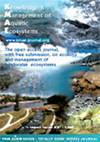Temporal trends and determinants of fish biomass in two contrasting natural lake systems: insights from a spring long-term monitoring scheme
IF 1.7
3区 环境科学与生态学
Q3 FISHERIES
引用次数: 4
Abstract
Freshwater fish declines are triggered by a suite of anthropogenic threats, including habitat degradation, climate and land use change, biological invasions, pollution and overfishing. Robust monitoring schemes are needed to understand and detect any effects of different factors on freshwater fish abundance and to be able to predict and respond to potential stressors. Here, we used standardized biomass-per-unit-effort (BPUE) data deriving from gillnet sampling over a 34-year period in the two Prespa Lakes and determined species trends using general additive models coupled with structural change models. Furthermore, the influence of seven environmental variables was assessed for each fish species using an analytical approach based on random forests. We showed that the total annual BPUE is increasing in Lake Mikri Prespa whereas it is stable in Megali Prespa and that the relative BPUE of introduced species in the former is increasing through the years. Differences in the lakes' trophic status were reflected in species trend patterns. Random forests showed that air temperature, the introduction of the invasive Lepomis gibbosus, predation and water management played a role in shaping species biomass in Mikri Prespa whereas abiotic factors are the main drivers of biomass changes in Megali Prespa. Our results provide empirical evidence on the importance of long-term monitoring in distinguishing between direct and indirect effects of large-scale stressors on fish abundance as well as insights towards sustaining the integrity of fish communities.两种不同自然湖泊系统中鱼类生物量的时间趋势和决定因素:来自春季长期监测方案的见解
淡水鱼数量减少是由一系列人为威胁引发的,包括栖息地退化、气候和土地利用变化、生物入侵、污染和过度捕捞。需要健全的监测计划来了解和检测不同因素对淡水鱼丰度的影响,并能够预测和应对潜在的压力源。在这里,我们使用了标准化的单位努力生物量(BPUE)数据,这些数据来自于34年来在两个Prespa湖的刺网采样,并使用一般的加性模型和结构变化模型来确定物种趋势。此外,利用基于随机森林的分析方法,评估了7个环境变量对每种鱼类的影响。结果表明,Mikri Prespa湖的年总生态生态价值呈上升趋势,而Megali Prespa湖的年生态生态价值保持稳定,而Mikri Prespa湖引进物种的相对生态生态价值呈逐年上升趋势。湖泊营养状况的差异反映在物种趋势格局上。随机森林研究结果表明,气温、入侵物种Lepomis gibbosus的引入、捕食和水管理对Mikri Prespa物种生物量的形成起作用,而非生物因素是Megali Prespa物种生物量变化的主要驱动因素。我们的研究结果提供了经验证据,证明了长期监测在区分大规模压力源对鱼类丰度的直接和间接影响方面的重要性,以及对维持鱼类群落完整性的见解。
本文章由计算机程序翻译,如有差异,请以英文原文为准。
求助全文
约1分钟内获得全文
求助全文
来源期刊

Knowledge and Management of Aquatic Ecosystems
环境科学-海洋与淡水生物学
CiteScore
3.70
自引率
5.60%
发文量
22
审稿时长
>12 weeks
期刊介绍:
Knowledge and Management of Aquatic Ecosystems (KMAE-Bulletin Français de la Pêche et de la Pisciculture since 1928) serves as a foundation for scientific advice across the broad spectrum of management and conservation issues related to freshwater ecosystems.
The journal publishes articles, short communications, reviews, comments and replies that contribute to a scientific understanding of freshwater ecosystems and the impact of human activities upon these systems. Its scope includes economic, social, and public administration studies, in so far as they are directly concerned with the management of freshwater ecosystems (e.g. European Water Framework Directive, USA Clean Water Act, Canadian Water Quality Guidelines, …) and prove of general interest to freshwater specialists. Papers on insular freshwater ecosystems and on transitional waters are welcome. KMAE is not a preferred journal for taxonomical, physiological, biological, toxicological studies, unless a clear link to ecological aspects can be established. Articles with a very descriptive content can be accepted if they are part of a broader ecological context.
 求助内容:
求助内容: 应助结果提醒方式:
应助结果提醒方式:


